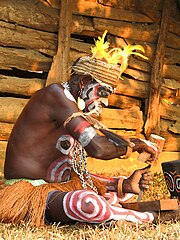 The Asmat are an ethnic group of New Guinea, residing in the Papua province of Indonesia. Having one of the most well-known and vibrant woodcarving traditions in the Pacific, their art is sought by collectors worldwide. The Asmat inhabit a region on the island's southwestern coast bordering the Arafura Sea,
with lands totaling approximately 18,000 km2 (7,336 mi2) and consisting
of mangrove, tidal swamp, freshwater swamp, and lowland rainforest. The land of Asmat is located both within and adjacent to Lorentz National Park and World Heritage Site,
the largest protected area in the Asia-Pacific region. The total Asmat
population is estimated to be around 70,000. The term "Asmat" is used to
refer both to the people and the region they inhabit.
The Asmat are an ethnic group of New Guinea, residing in the Papua province of Indonesia. Having one of the most well-known and vibrant woodcarving traditions in the Pacific, their art is sought by collectors worldwide. The Asmat inhabit a region on the island's southwestern coast bordering the Arafura Sea,
with lands totaling approximately 18,000 km2 (7,336 mi2) and consisting
of mangrove, tidal swamp, freshwater swamp, and lowland rainforest. The land of Asmat is located both within and adjacent to Lorentz National Park and World Heritage Site,
the largest protected area in the Asia-Pacific region. The total Asmat
population is estimated to be around 70,000. The term "Asmat" is used to
refer both to the people and the region they inhabit.
Culture and subsistence
The natural environment has been a major factor affecting the Asmat, as their culture and way of life are heavily dependent on the rich natural resources found in their forests, rivers, and seas. The Asmat mainly subsist on starch from the sago palm (Metroxylon sagu), fish, forest game, and other items gathered from their forests and waters. Materials for canoes, dwellings, and woodcarvings are also all gathered locally, and thus their culture and biodiversity are intertwined. Due to the daily flooding which occurs in many parts of their land, Asmat dwellings have typically been built two or more meters above the ground, raised on wooden posts. In some inland regions, the Asmat have lived in tree houses, sometimes as high as 25 meters from the ground. The Asmat have traditionally placed great emphasis on the veneration of ancestors, particularly those who were accomplished warriors. Asmat art, most noticeably elaborate, stylized wood carving, is designed to honour ancestors. Many Asmat artifacts have been collected by the world's museums, among the most notable of which are those found in the Michael C. Rockefeller Collection at the Metropolitan Museum of Art in New York City and the Tropenmuseum in Amsterdam.Traditionally, many Asmat men practiced polygyny by marrying more than one woman. In many cases, men were expected to marry a male relative's wife if that male relative died (otherwise the woman and her children would be left without a source of protection or economic support). Schneebaum reported that many Asmat men had long-term ritual sexual/friendship relationships (mbai) with other men, although the prevalence of this practice has been disputed by others. In the mbai system, male partners were also known to share their wives in a practice called papitsj. It is probable that missionary influence in the last several decades has reduced the occurrence of both mbai and papitsj.
Language and ethnic sub-groups
Linguistic classification of the native language(s) of the Asmat people is somewhat problematic, but is generally characterized as being a group of closely related languages or dialects (most mutually intelligible to some degree), known as the Asmat family, which is a sub-family of the Trans–New Guinea language phylum. However, some ethnic groups who speak languages in the Asmat language family, such as the Kamoro and Sempan peoples who live adjacent to the Asmat, are ethnically distinct from Asmat.Asmat may be thought of as an umbrella term for twelve different ethnic sub-groups with shared linguistic and cultural affinities and sense of shared identity. These twelve Asmat groups include Joirat, Emari Ducur, Bismam, Becembub, Simai, Kenekap, Unir Siran, Unir Epmak, Safan, Aramatak, Bras, and Yupmakcain. Further complicating the issue, these groups speak approximately five dialects (Casuarina Coast Asmat, Yaosakor Asmat, Central Asmat, North Asmat, Citak). However, at some important level these groups share a sense of identity and would likely refer to themselves as "Asmat".
